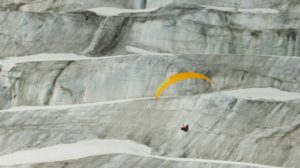The comforts of our daily lives may hinder many of us from seeking anything beyond our conventional ways of living. With a career in capturing thrilling moments, Squamish-based extreme filmmaker Bryan Smith chooses a different path. Searching for the globe’s wildest locations, he captures impressive athleticism among the remarkable landscapes of remote locations left untouched by the irreversible grip of modern civilization.
Smith is speaking here in Victoria this month through National Geographic’s Nat Geo Live series; he started his relationship with National Geographic by providing them with short snippets of footage, which eventually led to his first big pitch: taking kayaks to Kamchatka, a remote peninsula in far eastern Russia.

“It was a place on the map that represented one of the last truly wild places on earth,” says Smith. “And no one had been there with kayaks before.”
Although Smith has travelled all over the world, his trip to Kamchatka in 2011 continues to be one of his most memorable expeditions within the last decade.
“When people ask me, ‘What was the best expedition you ever went on?’ I’m like, ‘Oh, it’s definitely Kamchatka,’” he says. “I don’t know if I’m jaded, but I still think the landscape itself… I mean, I’ve never seen fish in rivers like that before. You hear all these stories from hundreds of years ago when people were walking across the rivers on fish. That is what Kamchatka is like.”
Smith says that another memorable expedition was one that he had in Papua New Guinea.
“It’s really wild in terms of the jungle and the rainforest but, culturally, it was the wildest place I’d ever been,” he says. “I mean, there are still literally thousands of dialects in Papua New Guinea so, tribally, you have people that pretty much live in isolation and speak their own language. Just to experience that in a small area, some place the size of southern Vancouver Island—just the bottom half of it—[and] to have a really proficient translator not even be able to translate or understand what the people were saying was kind of like that experience in Kamchatka—that feeling of stepping back in time.”
Although Smith and his team are all trained professionals, it doesn’t completely eliminate the risk factor of what he does. A lot of trust goes into knowing whether the adrenaline-pumping stunts are worth capturing.
“We choose to work with people that are the best at what they do and my feeling is that they have the better judgment,” says Smith. “They have the years of experience. There’s a lot of trust involved and I think that anxiety is dissipated in developing a relationship and trust with those individuals.”
During moments of filming, Smith doesn’t always fully register the extent of the risk being taken until after the fact.
“You’re highly focused on capturing the image or telling the story; you don’t have time to be scared, you only have time to be focused,” he says. “Sometimes it’s afterwards where you’re just like, ‘Holy shit; that was crazy,’ but in the moment itself, just like the athlete is totally focused on running a big waterfall, you’re making sure your exposure is correct and you’ve got your framing right. Because a lot of the things we’re filming, they only happen once.”
Smith urges people to take risks—whether they be big or they be small—in their own lives.
“You know what? If you get outside of your comfort zone and you try something you’ve never tried before, you learn. And the vast majority of people that surround us in our day-to-day lives do the same things every single day. It’s so programmed,” he says. “I constantly get bombarded with, ‘Oh my god, that’s the craziest thing ever, like, total adrenaline junkie, thrill-seeking, crazy—it’s crazy!’ And it’s like, no, it’s actually not. It’s about experiencing life, period. And, yeah sure, maybe what we do is a little bit more extreme but I say this to a lot of people: you could literally just drive a different way to work every day and you would see so much more of what happens around you.”
Nat Geo Live: Capturing the Impossible (with Bryan Smith)
Wednesday, November 20
$37.50 and up, Royal Theatre
$20 student rush tickets available day of show through box office
rmts.bc.ca
